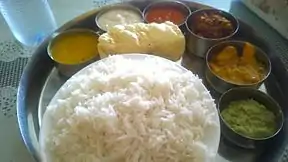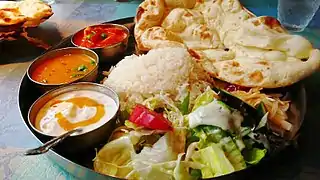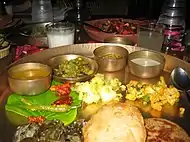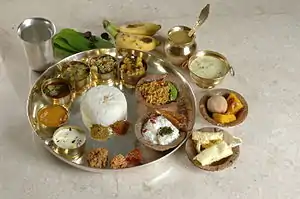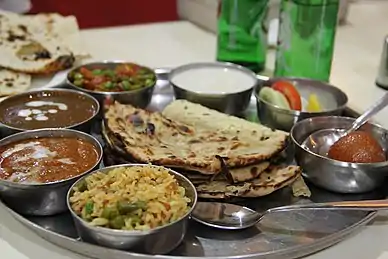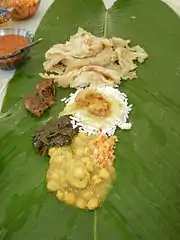Thali
Thali (meaning "plate") is a round platter used to serve food in the Indian subcontinent and Southeast Asia. Thali is also used to refer to an Indian-style meal made up of a selection of various dishes which are served on a platter.
Thali is also used in south Asia for ceremonial purposes.
History
As noted by INTACH, the earliest evidence of use of continuity in cooking and food habits of India can be established by the existence of tandoor (cooking oven), thali, lotas and chakla-belan for making chapatis found in excavations at Indus Valley Civilization site of Kalibangan (3500 BCE – 2500 BCE).[1]
In the early days, thalis were only reserved for royalty. Emperors feasted on the bountiful meal that was offered to them by the villagers and servants. Thalis were known as the “rich mans” food and only the elite and rich would feast.
Thali meal
Thali refers to the metal plate that a thali meal may be served on. Thali is popular in Punjab,[2] Uttar Pradesh and other states in North India. The idea behind a thali is to offer all the 6 different flavours of sweet, salt, bitter, sour, astringent and spicy on one single plate (technically the last two are actually forms of chemesthesis rather than true flavours). According to Indian food custom, a proper meal should be a perfect balance of all these six flavours. Restaurants typically offer a choice of vegetarian or meat-based thalis. Vegetarian thalis are very typical and commonplace in Tamil Nadu canteens (and South India, Sri Lanka, the Maldives, Mauritius, Fiji, the Caribbean and Southeast Asia except Vietnam and the Philippines in general), and are a popular lunch choice.
Dishes served in a thali vary from region to region in the Indian subcontinent and are usually served in small bowls, called katori in India. These katoris are placed along the edge of the round tray, the actual thali; sometimes a steel tray with multiple compartments is used. Typical dishes include rice, dal, vegetables, roti, papad, dahi (yogurt), small amounts of chutney or pickle, and a sweet dish to top it off.[3][4] Rice or roti is the usual main dish that occupies the central portion of the thali, while side dishes like vegetable curries and other aforementioned delicacies are lined circularly along the round thali. Depending on the restaurant or the region, the thali consists of delicacies native to that region. In general, a thali begins with different types of breads such as puris or chapatis (rotis) and different vegetarian specialities (curries). However, in South India and Southeast Asia, rice is the only staple served with thalis. Thalis are sometimes referred to by the regional characteristic of the dishes they contain. For example, one may encounter Nepalese thali, Rajasthani thali, Gujarati thali and Maharashtrian thali. In many parts of India, Pakistan, Afghanistan, Bangladesh and Nepal, the bread and the rice portions are not served together in the thali. Typically, the bread is offered first with rice being served afterwards, often in a separate bowl or dish.
Today, restaurants around the world offer thali dishes. The platters are made of stainless steel and some have intricate designs along the edges.
Unlimited thali
Unlimited thalis are those that come with limitless refills.[5][6] Kunal Vijaykar considers an unlimited thali as quintessentially Indian, not just for variety or limitlessness, but because it is true to Indian tradition.[7]
Affordability
The Economic Survey of India 2020 has a section called Thalinomics which shows an increase in affordability of a vegetable 'thali' by 29% and by non-vegetarian by 18% during 2006-07 to 2019-20.[8]
See also
References
- "INTACH Haryana newsletter", INTACH, page 34.
- Mayhew, B.; Bindloss, J.; Armington, S. (2006). Nepal. Ediz. Inglese. Country Guides (in Turkish). Lonely Planet. p. 104. ISBN 978-1-74059-699-2. Retrieved 5 March 2015.
- "Decording Indian Cuisine", in Spicy Thali blog, 26 June 2011. (Entry. Retrieved 3 June 2012)
- Andrew Marshall (15 February 2020). "The world on a plate". Vancouver Sun. p. G1.
- Desai, Anjali H. (2007). India Guide Gujarat. India Guide Publications. ISBN 9780978951702.
- Planet, Lonely; Singh, Sarina; Benanav, Michael; Blasi, Abigail; Clammer, Paul; Elliott, Mark; Harding, Paul; Mahapatra, Anirban; Noble, John (1 September 2015). Lonely Planet India. Lonely Planet. ISBN 9781743609750.
- "Kunal Vijayakar picks the best places to savour an unlimited thali in Mumbai". 21 April 2017. Retrieved 9 July 2017.
- "Economic Survey 2020: Veg thali affordability improves by 29%; non-veg by 18% during 2006-07 to 2019-20". The Times of India. 31 January 2020. Retrieved 31 January 2020.
Further reading
| Wikimedia Commons has media related to Thali. |
- Setalvad, Naini (2 May 2010), "The scientific Indian thali", Deccan Chronicle, archived from the original on 20 September 2010.
